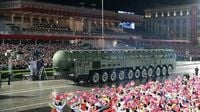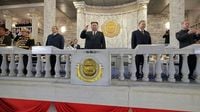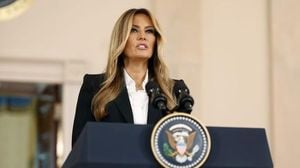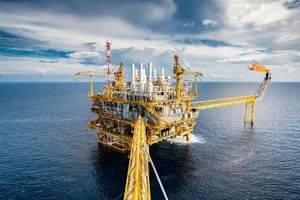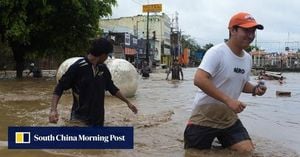Rain poured down on Pyongyang’s Kim Il Sung Square, but the downpour did little to dampen the spectacle or the message North Korea intended to send. On the night of October 10, 2025, North Korean leader Kim Jong Un presided over a massive military parade marking the 80th anniversary of the ruling Workers’ Party of Korea, unveiling a new generation of weaponry and signaling a bold diplomatic posture to the world. The event, attended by thousands of spectators and a notable roster of foreign dignitaries, showcased North Korea’s most advanced missile systems and its deepening ties with Russia and China.
According to the Korean Central News Agency (KCNA), the centerpiece of the parade was the debut of the Hwasong-20 intercontinental ballistic missile (ICBM), described as the country’s “most powerful nuclear strategic weapon system.” Mounted atop an imposing 11-axle transporter-launch vehicle, the Hwasong-20 has yet to be flight-tested, but its mere presence was enough to ignite speculation among military analysts and raise concerns in capitals across the globe. State media highlighted that the missile’s new solid-fuel rocket engine, built with carbon fiber composite materials, is not only more powerful than previous models but also allows for quicker launch readiness—making it harder to detect and intercept.
The Hwasong-20 wasn’t the only technological marvel on display. North Korea also rolled out the Hwasong-11Ma hypersonic glide vehicle, a short-range ballistic missile (SRBM) with a maneuverable warhead capable of traveling at over five times the speed of sound. As reported by CNN, this weapon, based on Russia’s Iskander missile design, is engineered to evade missile defenses by taking an unpredictable path toward its target. North Korea has been testing hypersonic glide vehicles since at least September 2021, and recent advancements include the use of solid-fueled boosters, which can be moved and fired with minimal preparation time.
KCNA reported, “The spectators broke into the most enthusiastic cheers when the column of Hwasong-20 ICBMs, the most powerful nuclear strategic weapon system of the DPRK, entered the square, filling the track.” The excitement wasn’t limited to missile enthusiasts; the parade also featured upgraded Cheonma-20 main battle tanks, which state media described as having “tremendous striking capability and (a) reliable protection system.” These tanks, along with columns of soldiers, rumbled through the illuminated square, symbolizing North Korea’s resolve and growing military prowess.
Yet, the parade was as much about politics and alliances as it was about military hardware. Among the foreign dignitaries in attendance were Chinese Premier Li Qiang, former Russian president Dmitry Medvedev (now deputy chairman of Russia’s Security Council), and Vietnamese Communist Party General Secretary To Lam. Their presence underscored Kim Jong Un’s increasingly assertive foreign policy and his efforts to break out of international isolation by forging a united front with fellow adversaries of the U.S.-led West.
Kim’s diplomatic push has gained momentum since his high-profile visit to Beijing in September 2025, where he stood shoulder to shoulder with Chinese President Xi Jinping and Russian President Vladimir Putin at a massive Chinese military parade. That trip, widely seen as a major diplomatic victory for Kim, led to deeper strategic ties and a renewed sense of purpose in advancing North Korea’s missile and nuclear weapons programs. Since Russia’s invasion of Ukraine, North Korea has prioritized its relationship with Moscow, sending thousands of troops and large shipments of weapons—including artillery and ballistic missiles—to support Russian forces. KCNA noted that the parade included “the invincible overseas operations unit that fully demonstrated the spirit of the Korean people,” referring to North Korean troops who fought alongside Russian forces to repel Ukrainian advances in the Kursk region earlier in 2025.
During the parade, Kim Jong Un delivered a speech urging his military to “continue to grow into an invincible entity that destroys all threats.” Notably, he refrained from directly mentioning the United States or South Korea, a calculated omission that some analysts interpret as an attempt to project strength without escalating tensions unnecessarily. Still, the array of weaponry on display—including shorter-range ballistic, cruise, and supersonic missiles capable of delivering nuclear strikes against South Korea—left little doubt about North Korea’s strategic intentions.
In addition to the hardware, the parade served as a platform for diplomatic maneuvering. On October 9 and 10, Kim held separate meetings with Medvedev, Li Qiang, and To Lam to discuss strengthening strategic partnerships and alliances. Medvedev, for his part, praised the “bravery and self-sacrificing spirit” of North Korean soldiers who fought alongside Russian troops and called for expanded exchanges and cooperation between the two governments. Kim’s meeting with the Vietnamese and Chinese officials similarly focused on bolstering ties and exploring new avenues for collaboration.
The timing of these high-level visits and military displays is no accident. North Korea has shunned dialogue with Washington and Seoul since the collapse of Kim’s nuclear diplomacy with former U.S. President Donald Trump in 2019. In recent public remarks, Kim has urged the United States to drop its demand for North Korea to surrender its nuclear arsenal as a precondition for resuming talks. Instead, Pyongyang is doubling down on its efforts to develop multi-warhead systems—technologies that could improve the odds of penetrating missile defenses and further complicate the security calculus for the U.S. and its allies.
Western observers have taken particular note of North Korea’s advances in solid-fuel missile technology, which mirrors lessons learned from Russia’s own battlefield experiences in Ukraine. While some analysts remain skeptical of the effectiveness of Russian hypersonic missiles like the Kinzhal, North Korea’s willingness to adopt similar designs and tactics indicates a clear desire to stay at the cutting edge of missile warfare.
Despite the impressive show of force, questions linger about the actual capabilities of the new weapons. The Hwasong-20, for example, has yet to undergo a public flight test, and it’s possible that what was displayed during the parade was merely a canister believed to contain the missile rather than the missile itself. Still, the symbolism was unmistakable: North Korea is determined to be seen as a formidable nuclear power, with the means to strike adversaries far beyond its borders if provoked.
For Pyongyang, the parade was more than just a celebration of the Workers’ Party’s eight decades in power—it was a carefully orchestrated message to friends and foes alike. As North Korea deepens its strategic ties with Russia and China while accelerating its weapons programs, the world is left to ponder the implications of a more confident and technologically advanced regime on the Korean Peninsula. The rain may have been relentless that night, but North Korea’s message came through loud and clear.
